Know Your Tree
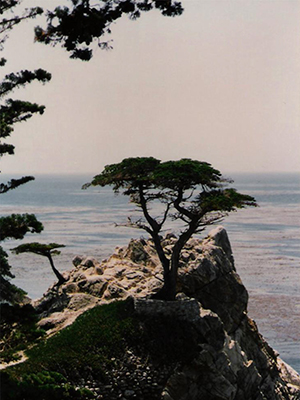
Golden Monterey Cypress
Cupressus Microcarpa Aurea
by Lew Buller
Not all of my attempts to create bonsai turn out to be Cinderella stories. I bought two cypresses for $3.98 each from the discontinued section of a nursery.
Having decided to become a generalist, I sold the second one at a reasonable price at a bonsai club sale and a friend bought it. Shortly thereafter, he informed me that he had resold it to someone who wanted it at twice the price he had paid for it. Didn’t even give me a commission on the sale.
The other I kept and worked on for several years. It taught me a great deal and I got a great satisfaction out of seeing it develop. The last thing it taught me was that I needed to learn something about grafting. I would have put foliage closer to the trunk; it doesn’t back-sprout.
The Monterey Cypress was originally found on the Monterey Peninsula in California. The Western Garden Book describes it “as a fast-growing windbreak tree in coastal conditions” and that limits its use as bonsai somewhat. It is in the same genus as the Arizona Cypress, the Tecate Cypress, and the Italian Cypress. I’m not sure where the Golden cultivar originated. Probably it was like the bougainvillea, developed from a sport. The original bougainvillea, the Brasiliensis, was purple; more than two dozen cultivars have been developed from sports on that plant.
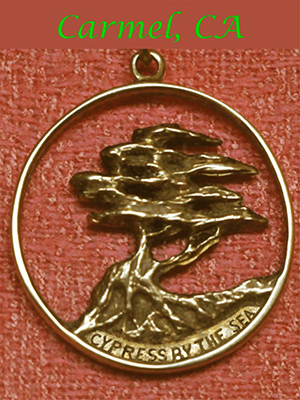
Cypress by the Sea is a famous Monterey cypress in Carmel, CA about 20 miles south of Monterey. The cypresses rank right up with the bald cypress (taxodium; not a Cupressus at all) in my affections. A jewelry store in Carmel had a gold pendant memorializing this cypress and I liked it so well that I bought it.

The Tecate cypress (forbesii) has a distinct look. In the ground, it is more like a multi-trunked bush. In a bonsai pot, it can be trained in other shapes. It is unusual in that it depends on fire for reproduction. No fires mean no new Tecate cypresses. When the tree burns, the heat melts the resin that has kept the cones sealed, and the seed is released. A fire in 2006 in Orange County, CA, the northernmost stand, caused regeneration of new trees by the hundreds of thousands. Bill Murphy, a retired school principal and a marvelous bonsai artist, developed this formal upright from a seedling but the plant is too old to be from the Orange fire.

The rest of these pages are devoted to the microcarpa. The Golden cultivar looked nothing like the Carmel cypress when I brought it home from the nursery. It never would; it is a different cultivar. My arborist friend and I had worked on the only Golden cultivar I ever saw–it was a single trunk almost formal upright–and I was curious to see how this one would grow. I knew one thing; the attachment of branches to trunk was weak; no extra wood built up around the joint. He stood on one of the lowest lateral branches and it promptly broke off. Split a heel off with it, too; it looked as if it had been severed by a sharp axe.
As you see photos of this tree developing, you will see that there is no extra wood at the joints of branches and trunk. I had no idea how the tree would respond to wiring, so wiring was very tentative at first. It had come from a San Diego nursery so I tried San Diego bonsai soil when I transplanted, and that worked.

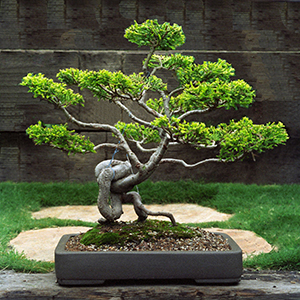
Two photos: one told me it was time to learn to wire, so I asked Ernie Kuo in Los Angeles if I could join his Saturday afternoon wiring class and he accepted me as a student. The other told me it was time to learn how to develop branches, so I took lessons from Ted Matson. Ted is so skilled at bonsai that one of his was used in the movie, “The Karate Kid.” He regularly teaches and does demonstrations.
Never remembered to date my photos, so I have no idea when most of them were taken. In my mind, however, I do see improvement from one photo to the next.
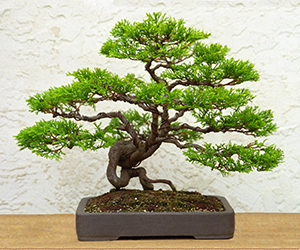
Look at the next photo and you will see that foliage pads have begun to develop and that branches have been wired down and set. In particular, look at the second branch on the left and note its improved position. Also, the very top is no longer a pom-pom but has begun to spread out and take on the profile of an old tree.
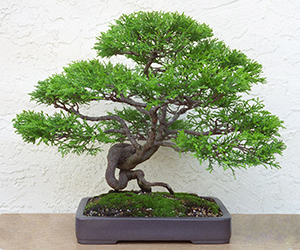
By the time I took another photo, I began to think about showing my tree. It still needed some refinement with some pads needing to be thinned out and others encouraged to grow more. I tested its appearance.

I got the stand in a Japanese antique store in Santa Barbara when my wife and I went up to visit her mother. It amuses me every time I look at that photo to think of a $3.98 tree in a $40.00 pot sitting on a $200 stand.
Martha Longenecker was Director of the Mingei Museum (Mingei means “folk art”) and she, like all bonsai aficionados, considered bonsai to be a living art. She and the Assistant Curator, Rob Sidner, asked me to help them create a bonsai collection that could be shown in the museum on a regular basis. We accumulated a collection by donations from friends and acquaintances and she showed bonsai in the Museum on a daily basis.
She also invited me to show my own trees on special occasions. They could stand being indoors for a couple of days so I showed a number of times. I showed this tree at an opening of a new exhibit.

Take a look at the other photos and you will see that this photo does not show exposed roots. Ernie Kuo had suggested that I stuff sphagnum moss under the exposed roots and cover it all with soil. I did. Moss grew.
I said at the beginning that this story did not have a Cinderella ending. The very shallow pot meant that this tree needed to be watered frequently. My health was such that I missed two days of watering during a hot spell and the tree died. It lives on in photos.
